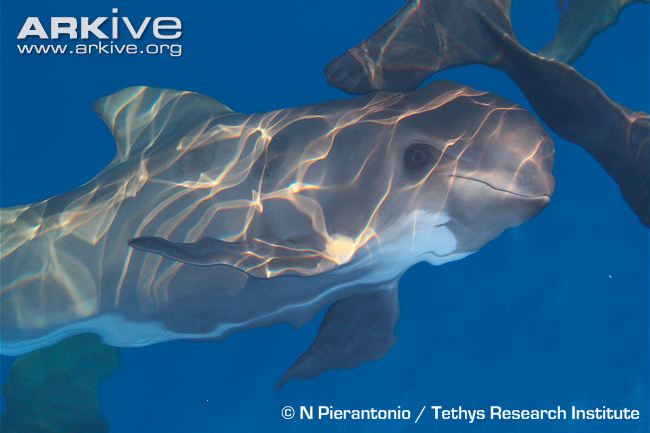Adaptation
Many times a species is distinguished by its outward appearance, and many species’ unique appearance actually helps them survive in the environment they find themselves apart of, such as the ocean. Whales are mammals and have many unique characteristics that link them to their land relatives. Long-finned pilot whales are no exception from the evolution for land to water, and scientists have seen evidence that links these whales to its land relatives (The Evolution of Whales 2013). There are also many characteristics that are unique to the long-finned pilot whale that help people identify them out in the open ocean.
Long-finned pilot whales can be black or gray in color with white stripes diagonally behind the eyes (NOAA 2012). Pilot whales have a lighter gray color on their belly and chin. Their closest relative, the short-finned pilot whale, is smaller than the long-finned pilot whale and have shorter pectoral fins. One of the pilot whales most distinctive traits is their large melon-shaped head (Preston 2011). The size of this melon head varies with age and sex (NOAA 2012). Male long-finned pilot whales can grow to a size up to 25 feet and females can grow up to 19 feet. Males can weigh as much as 5,000 pounds but the females are lighter, weighing in at about 2,900 pounds (NOAA 2012). Pilot whales can dive as deep up to 1,950 feet but, since they are mammals, have to return to the surface every 10 to 16 minutes. They can communicate with each other using whines, clicks, whistles and echolocation (Bioexpedition 2013). Echolocation allows whales to orientate themselves in space (Preston 2011). How these communication methods sound depend heavily on what is going on with the whale and the pod. They communicate differently when they are playing, mating, and even eating (NOAA 2012).
So, since whales are mammals, how did they end up in the water? This is a good question and the answer is actually in their structural make up. The blowhole that is on the top of whale’s head was actually once their nostrils and has evolved to be situated on top their head (The Evolution of Whales 2013). Also, their pelvic bone has evolved to be reduced in size and it is separate from the backbone. This may explain why whales swim different than fish. If you look at a fish swimming, they move their tail back and forth. Whales swim by oscillating their body up and down (The Evolution of Whales 2013). This unique motion evolved due to the fact that whale evolved from land mammals and land mammals’ backbones are not able to bend side to side but rather they bend up and down. There is also a lot of evidence of their evolution from land to water lies in their vestigial hind limb. They have all the same bones as land mammals do in their hind limbs (The Evolution of Whales 2013)!
Long-finned pilot whales have a very unique look to them, which includes their large melon-shaped head. They also have unique coloring and size along with longer pectoral fins hence their name. However, probably the most interesting thing that sets them apart from the rest of the ocean organisms is that they are related to land mammals. The evolution from land to water directly shows how whales adapted to a drastically different habitat and the pilot whales are no exception. Overall, whales are fascinating animals due to their many different forms and unique functions and the long-finned pilot whale is no exception.
<<Habitat Home Reproduction>>


